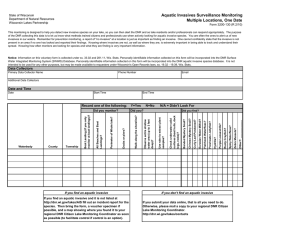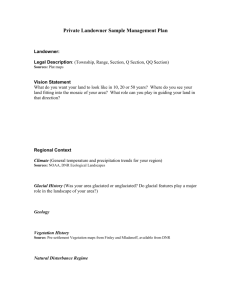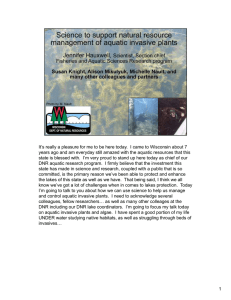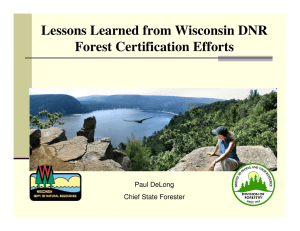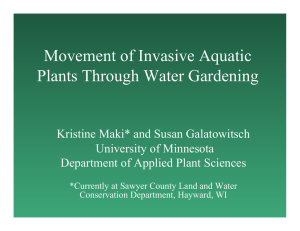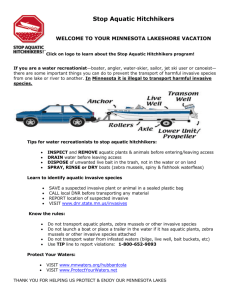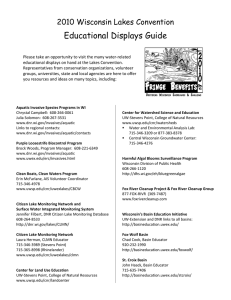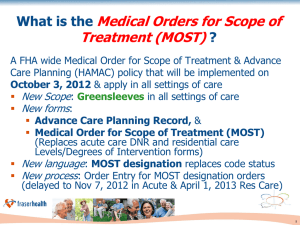Implementing the New Invasive Species Laws Presented by Bob Wakeman
advertisement
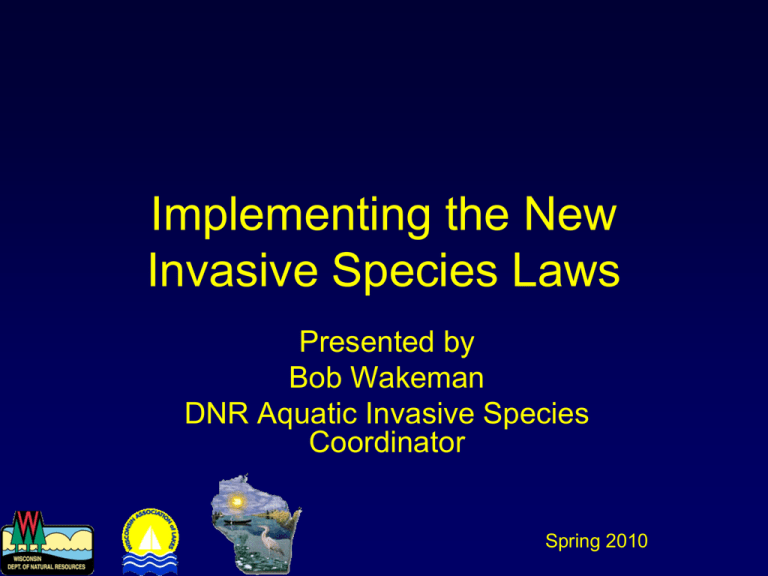
Implementing the New Invasive Species Laws Presented by Bob Wakeman DNR Aquatic Invasive Species Coordinator Spring 2010 Education & Outreach Support • Statewide message • Publications & boat launch signs • Displays & presentations • Media – TV, Radio, Newspaper, Bill boards, etc. Watercraft Inspection • Clean Boats, Clean Waters • volunteers trained to monitor local lakes DNR inspection program • staff monitor high traffic landings, lakes with invasive species • Water Guard • Contact: Erin Henegar WI Water Guard Volunteer Monitoring • Trained volunteers collect data on lake health including aquatic invasives • Data used to map extent of spread for species • Contact: Laura Herman Purple Loosestrife Biological Control • Trained volunteers raise & release beetles • Beetles available for free—great school or family project • Contact: Brock Woods Aquatic Invasive Species Grants FY09 Fall Grant Funding Cycle $377,174.00 $140,717.23 $1,253,560.29 $1,067,764.45 $4 million available annually Prevention Research & Demonstration Control Infestation Early Detection & Response From Research to Management • UW Madison Center for Limnology developing ―Smart Prevention‖ model • Model helps DNR make strategic management decisions • ACOE conducting research on low level chemical treatments for EWM • Community based market research Smart Prevention • Bringing together lake user organizations with political and business leaders to develop a plan to maximize containment and prevention of AIS in a region • Available tools – – – – – – CBCW Program CLMN Boat Wash Facilities Signs (Boat launch, billboards, etc.) Water Guard Media Blitz Wisconsin’s AIS Laws • Preventing the spread – VHS (viral hemorhagic septicemia) 2007 – Invasive Species Identification, Classification and Control (NR 40) 2009 – Wisconsin Act 55 (Illegal to transport AIS on highways) 2009 What is an ―Invasive Species‖? • Nonnative species whose introduction causes or is likely to cause economic or environmental harm or harm to human health (Wisconsin Statutes 23.22) – Plants (terrestrial and aquatic) – Animals (vertebrates and invertebrates) – Disease-causing organisms Why do we care? • Economic impacts – Fishing industry, tourism, property values • Ecological impacts – Native fish, invertebrates, plants • Recreational impacts – Boating, angling, swimming Prevention vs. Restoration Prevention is always cheaper than restoration. NR 40 Invasive Species Classification • Prohibited – Not yet in the state or established in pioneer stands only; still have potential to eradicate and prevent statewide; high potential for environmental damage if widely established. • Restricted – Already established in the state; high environmental impacts. Prohibited also includes: • All nonnative fish and crayfish except: – Established nonnative fish and crayfish – Fish in the aquarium trade – Fish in the aquaculture trade Restricted Control by classification • Restricted – Control encouraged but not required. • Prohibited – The department will seek control of prohibited species if it is feasible and reasonable to do so. Stepped Enforcement • Primary focus will be education and voluntary compliance. • If necessary, law enforcement may • Issue a citation • Refer the matter to the Department of Justice • Revoke a permit issued, after notice and opportunity for a hearing s. 23.22 (9), Stats Control Requirements (For prohibited species) DNR order is violated – DNR controls species and recovers costs DNR orders property owner to control species DNR controls species on property with owner consent Voluntary Control by property owner. Department will seek funds to assist owner. Permits - Anyone may transport, possess, transfer or introduce a prohibited or restricted species with a permit - Some exceptions apply. (Charlie Shong does not need a permit to haul EWM from Pewaukee Lake to his disposal site) A True Story Yellow floating-heart (Nymphoides peltata) A known Prohibited Species Yellow Floating Heart Location • History of Infestation (2007 - 2008 - 2009) – July, ‘07 found in two ponds – Chemical treatments unsuccessful. – Manual removal unsuccessful. – June 2009 application for Rapid Response Grant (75% Cost Share, max. $20,000) • Goal - eradication Rapid Response Plan Step 1 • Dewater Ponds through sediment bags in order to retain all seeds Rapid Response Plan Step 2 • Dredge to Existing Clay Liner – Place dredge spoils in newly excavated pits near ponds – Trucking spoils to a disposal site was discussed & discarded – more expensive, greater chance that seeds could be dispersed Rapid Response Plan Step 3 • Place liner in ponds to prevent any remaining seeds from germinating Rapid Response Plan Step 4 - 6 • Cap Spoil Pits • Allow Ponds to refill • Monitor for 3 years Esquire Estate – Germantown, WI Stormwater Detention Pond Residential Development Red Swamp Crayfish • Project Sequence – – – – – – Local citizen observed and called DNR to investigate Containment action taken quickly Trapping revealed significant population Education of subdivision owners Law enforcement presence Eradication strategy developed and implemented by DNR – Treatment with Bleach – Follow up monitoring in 2010 Do you mean I’m not in Louisiana? Eggs Trapping Red Swamp Crayfish provided insight into the size of the population. Trap Staff Investment Chemical Control Safety First Treatment Day Media Coverage Aquatic Invasive Species Laws • For more information; – http://dnr.wi.gov/invasives/ Thanks for helping Resources for More Information • Web addresses – DNR site: www.dnr.state.wi.us/invasives/aquatic/ – UWEX Lakes site: www.uwsp.edu/cnr/uwexlakes/ • Staff contacts – Julia Solomon—General questions, pub orders, information • 608-267-3531 julia.solomon@wisconsin.gov – Erin Henegar—Clean Boats, Clean Waters • 715-346-4978 ehenegar@uwsp.edu – Laura Herman—Citizen Lake Monitoring Network • 715-346-3989 lherman@uwsp.edu – Brock Woods—Purple Loosestrife Biocontrol • 608-221-6349 brock.woods@wisconsin.gov – Carroll Schaal—Aquatic invasive species grants • 608-261-6423 carroll.schaal@wisconsin.gov – Bob Wakeman —Policy, budget & program information • (262) 574 – 2149 robert.wakeman@wisconsin.gov
